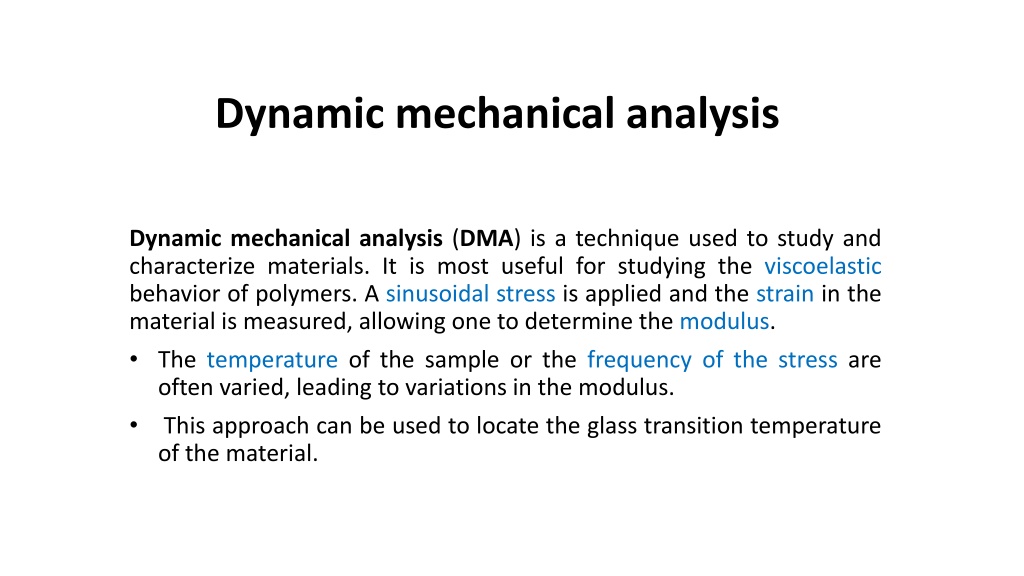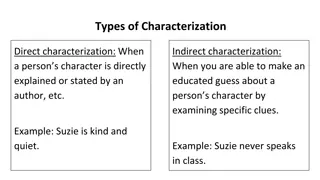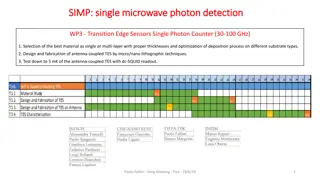Exploring Dynamic Mechanical Analysis (DMA) for Material Characterization
Dynamic Mechanical Analysis (DMA) is a valuable technique for studying viscoelastic behavior in materials, particularly polymers. By applying sinusoidal stress and measuring strain, DMA helps determine modulus and locate the glass transition temperature. The method involves varying temperature or stress frequency to analyze modulus variations. DMA measures stiffness and damping as storage and loss moduli, respectively. Tan delta, the ratio of loss to storage, characterizes material's energy dissipation capability. The higher tan delta, the more dissipative the material, while lower tan delta indicates increased elasticity potential. Examples like nano-composites show how material composition affects tan delta values.
Download Presentation

Please find below an Image/Link to download the presentation.
The content on the website is provided AS IS for your information and personal use only. It may not be sold, licensed, or shared on other websites without obtaining consent from the author. Download presentation by click this link. If you encounter any issues during the download, it is possible that the publisher has removed the file from their server.
E N D
Presentation Transcript
Dynamic mechanical analysis Dynamic mechanical analysis (DMA) is a technique used to study and characterize materials. It is most useful for studying the viscoelastic behavior of polymers. A sinusoidal stress is applied and the strain in the material is measured, allowing one to determine the modulus. The temperature of the sample or the frequency of the stress are often varied, leading to variations in the modulus. This approach can be used to locate the glass transition temperature of the material.
A typical DMA tester with grips to hold sample and environmental chamber to provide different temperature conditions. A sample is mounted on the grips and the environmental chamber can slide over to enclose the sample.
DMA measures stiffness and damping, these are reported as modulus and tan delta. Because sinusoidal stress is applied, modulus can be expresesed as; in-phase component, the storage modulus (E ) and out of phase component, the loss modulus (E") Storage modulus (E ) is a measure of elastic response of a material. It measures the stored energy. Loss modulus (E") is a measure of viscous response of a material. It measures the energy dissipated as heat.
Tan delta is the ratio of loss to the storage and is called damping. It is a measure of the energy dissipation of a material. It tells us how good a material will be at absorbing energy. Basically tan delta can be used to characterize the modulus of the material. Delta should range between 0 and 90 and as delta approaches 0 it also approaches a purely elastic behaviour. As delta approached 90 the material approaches a purely viscous behaviour. The tan of delta is defined below: tan(delta) = E"/E' E" = storage modulus E' = loss modulus
Assume that you apply a load to a polymer, some part of the applied load is dissipated by the energy dissipation mechanisms ( such as segmental motions) in the bulk of polymer , and other part of the load is stored in the material and will be release upon removal of the load (such as the elastic response of a spring!). Increasing Tan delta indicates that your material has more energy dissipation potential so the greater the Tan delta, the more dissipative your material is. Decreasing Tan delta means that your material acts more elastic now and by applying a load, it has more potential to store the load rather than dissipating it! For example, in case of nano-composites ( and filled polymers), increasing the nano- particle content diminishes the value of Tan delta as nano-particles impose restrictions against molecular motion of polymer chains ( due to the adsorption of polymer chain on the surface of the particles) resulting in more elastic response of the material.
For polycaprolactone measured at a meachnical vibration frequency of 1 Hz is shown below: The drop in storage modulus (E') and peak in damping factor (tan delta) between -60 and - 30 C is due to the glass transition (Tg) of the amorphous polymer in this semi-crystalline material. Above 50 C the sample begins to melt and flow, thus loosing all mechanical integrity. Below the Tg small peaks are evident in the tan delta curve at -80 and -130 C. These are the beta and gamma transtions in this polymer (the glass transition is known also as the alpha transition) and are caused by local motion of the polymer chains as opposed to large scale co-operative accompanies the Tg. These small transitions are very difficult to observe by DSC but are often very important in determining the impact resistance of the polymer. example, the DMA curve of motion that
Dynamic Mechanical Analysis: A Practical Introduction, Second Edition Yazar: Kevin P. Menard























